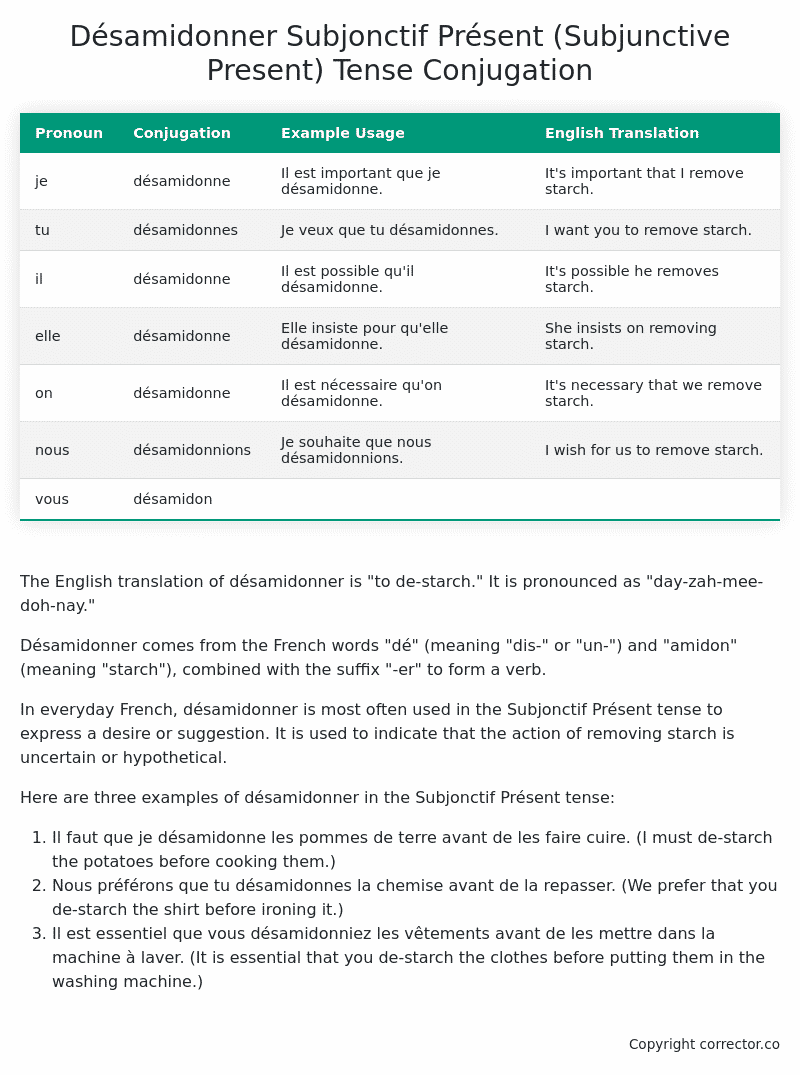Subjonctif Présent (Subjunctive Present) Tense Conjugation of the French Verb désamidonner
Introduction to the verb désamidonner
The English translation of désamidonner is “to de-starch.” It is pronounced as “day-zah-mee-doh-nay.”
Désamidonner comes from the French words “dé” (meaning “dis-” or “un-“) and “amidon” (meaning “starch”), combined with the suffix “-er” to form a verb.
In everyday French, désamidonner is most often used in the Subjonctif Présent tense to express a desire or suggestion. It is used to indicate that the action of removing starch is uncertain or hypothetical.
Here are three examples of désamidonner in the Subjonctif Présent tense:
- Il faut que je désamidonne les pommes de terre avant de les faire cuire. (I must de-starch the potatoes before cooking them.)
- Nous préférons que tu désamidonnes la chemise avant de la repasser. (We prefer that you de-starch the shirt before ironing it.)
- Il est essentiel que vous désamidonniez les vêtements avant de les mettre dans la machine à laver. (It is essential that you de-starch the clothes before putting them in the washing machine.)
Table of the Subjonctif Présent (Subjunctive Present) Tense Conjugation of désamidonner
| Pronoun | Conjugation | Example Usage | English Translation |
|---|---|---|---|
| je | désamidonne | Il est important que je désamidonne. | It’s important that I remove starch. |
| tu | désamidonnes | Je veux que tu désamidonnes. | I want you to remove starch. |
| il | désamidonne | Il est possible qu’il désamidonne. | It’s possible he removes starch. |
| elle | désamidonne | Elle insiste pour qu’elle désamidonne. | She insists on removing starch. |
| on | désamidonne | Il est nécessaire qu’on désamidonne. | It’s necessary that we remove starch. |
| nous | désamidonnions | Je souhaite que nous désamidonnions. | I wish for us to remove starch. |
| vous | désamidon |
Other Conjugations for Désamidonner.
Le Present (Present Tense) Conjugation of the French Verb désamidonner
Imparfait (Imperfect) Tense Conjugation of the French Verb désamidonner
Passé Simple (Simple Past) Tense Conjugation of the French Verb désamidonner
Passé Composé (Present Perfect) Tense Conjugation of the French Verb désamidonner
Futur Simple (Simple Future) Tense Conjugation of the French Verb désamidonner
Futur Proche (Near Future) Tense Conjugation of the French Verb désamidonner
Plus-que-parfait (Pluperfect) Tense Conjugation of the French Verb désamidonner
Passé Antérieur (Past Anterior) Tense Conjugation of the French Verb désamidonner
Futur Antérieur (Future Anterior) Tense Conjugation of the French Verb désamidonner
Subjonctif Présent (Subjunctive Present) Tense Conjugation of the French Verb désamidonner (this article)
Subjonctif Passé (Subjunctive Past) Tense Conjugation of the French Verb désamidonner
Subjonctif Imparfait (Subjunctive Imperfect) Tense Conjugation of the French Verb désamidonner
Conditionnel Présent (Conditional Present) Tense Conjugation of the French Verb désamidonner
Conditionnel Passé (Conditional Past) Tense Conjugation of the French Verb désamidonner
L’impératif Présent (Imperative Present) Tense Conjugation of the French Verb désamidonner
L’infinitif Présent (Infinitive Present) Tense Conjugation of the French Verb désamidonner
Struggling with French verbs or the language in general? Why not use our free French Grammar Checker – no registration required!
Get a FREE Download Study Sheet of this Conjugation 🔥
Simply right click the image below, click “save image” and get your free reference for the désamidonner Subjonctif Présent tense conjugation!

Désamidonner – About the French Subjonctif Présent (Subjunctive Present) Tense
Formation of the Subjonctif Présent
Common Everyday Usage Patterns
Interactions with Other Tenses
Summary
I hope you enjoyed this article on the verb désamidonner. Still in a learning mood? Check out another TOTALLY random French verb conjugation!


